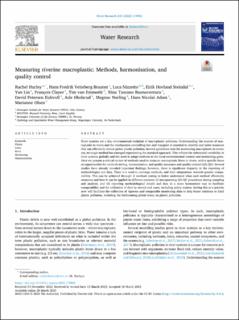| dc.contributor.author | Hurley, Rachel | |
| dc.contributor.author | Braaten, Hans Fredrik Veiteberg | |
| dc.contributor.author | Nizzetto, Luca | |
| dc.contributor.author | Steindal, Eirik Hovland | |
| dc.contributor.author | Lin, Yan | |
| dc.contributor.author | Clayer, Francois | |
| dc.contributor.author | Emmerik, Tim van | |
| dc.contributor.author | Buenaventura, Nina Tuscano | |
| dc.contributor.author | Eidsvoll, David Pettersen | |
| dc.contributor.author | Økelsrud, Asle | |
| dc.contributor.author | Norling, Magnus Dahler | |
| dc.contributor.author | Adam, Hans Nicolai | |
| dc.contributor.author | Olsen, Marianne | |
| dc.date.accessioned | 2023-09-21T13:23:05Z | |
| dc.date.available | 2023-09-21T13:23:05Z | |
| dc.date.created | 2023-03-29T08:33:20Z | |
| dc.date.issued | 2023 | |
| dc.identifier.citation | Water Research. 2023, 235, 119902. | en_US |
| dc.identifier.issn | 0043-1354 | |
| dc.identifier.uri | https://hdl.handle.net/11250/3091118 | |
| dc.description.abstract | River systems are a key environmental recipient of macroplastic pollution. Understanding the sources of macroplastic to rivers and the mechanisms controlling fate and transport is essential to identify and tailor measures that can effectively reduce global plastic pollution. Several guidelines exist for monitoring macroplastic in rivers; yet, no single method has emerged representing the standard approach. This reflects the substantial variability in river systems globally and the need to adapt methods to the local environmental context and monitoring goals. Here we present a critical review of methods used to measure macroplastic flows in rivers, with a specific focus on opportunities for methods testing, harmonisation, and quality assurance and quality control (QA/QC). Several studies have already revealed important findings; however, there is significant disparity in the reporting of methodologies and data. There is a need to converge methods, and their adaptations, towards greater comparability. This can be achieved through: i) methods testing to better understand what each method effectively measures and how it can be applied in different contexts; ii) incorporating QA/QC procedures during sampling and analysis; and iii) reporting methodological details and data in a more harmonised way to facilitate comparability and the utilisation of data by several end users, including policy makers. Setting this as a priority now will facilitate the collection of rigorous and comparable monitoring data to help frame solutions to limit plastic pollution, including the forthcoming global treaty on plastic pollution. | en_US |
| dc.language.iso | eng | en_US |
| dc.publisher | Elsevier | en_US |
| dc.rights | Navngivelse 4.0 Internasjonal | * |
| dc.rights.uri | http://creativecommons.org/licenses/by/4.0/deed.no | * |
| dc.title | Measuring riverine macroplastic: Methods, harmonisation, and quality control | en_US |
| dc.type | Peer reviewed | en_US |
| dc.type | Journal article | en_US |
| dc.description.version | publishedVersion | en_US |
| dc.rights.holder | © 2023 The Authors | en_US |
| dc.source.pagenumber | 14 | en_US |
| dc.source.volume | 235 | en_US |
| dc.source.journal | Water Research | en_US |
| dc.identifier.doi | 10.1016/j.watres.2023.119902 | |
| dc.identifier.cristin | 2137839 | |
| dc.relation.project | Norges forskningsråd: 302575 | en_US |
| dc.source.articlenumber | 119902 | en_US |
| cristin.ispublished | true | |
| cristin.fulltext | original | |
| cristin.qualitycode | 2 | |

